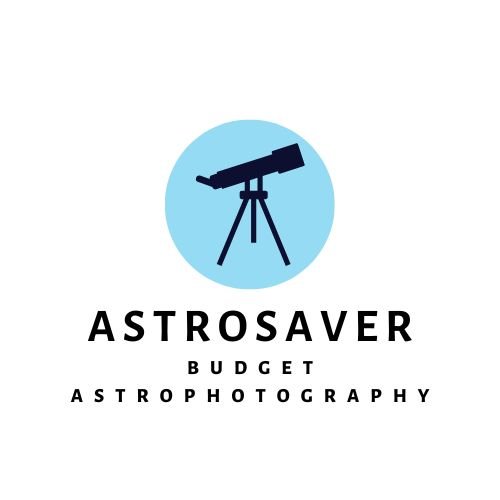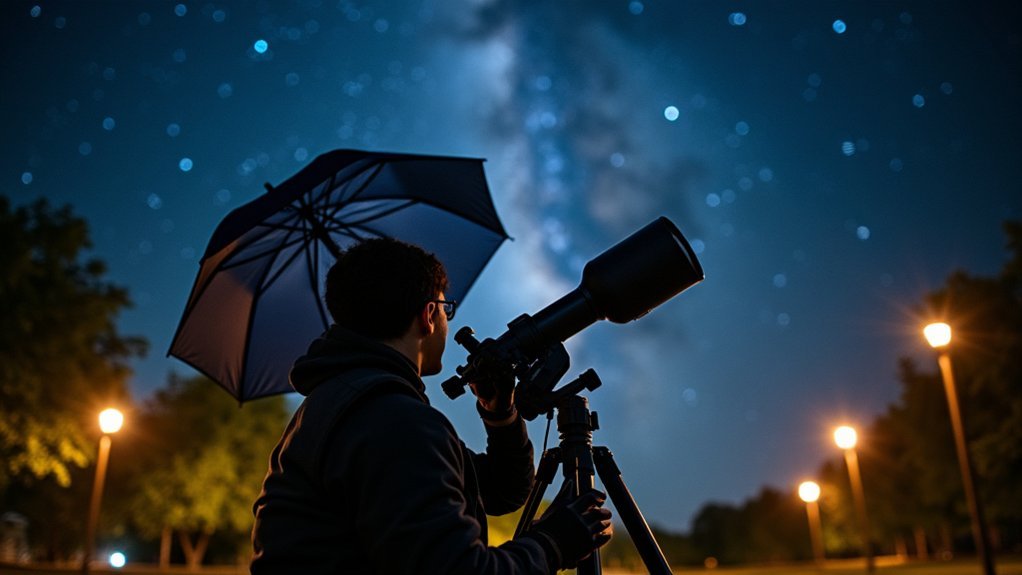The Tangent Drive Tracker offers budget-friendly astrophotography at under $10, letting you capture detailed celestial images with exposures longer than handheld shots allow. Built with simple components like a hinge and threaded drive screw, this DIY mount counteracts Earth’s rotation when properly aligned to the celestial pole. It supports lenses up to 135mm while operating at approximately 0.735 RPM. With proper calibration and sine function compensation, you’ll minimize tracking errors and capture sharper star images throughout your night sky adventures.
Tangent Drive Tracker: Affordable Astrophotography With Precision
While high-end star trackers can cost hundreds of dollars, the tangent drive tracker stands out as an exceptional budget alternative that doesn’t compromise on functionality.
You can build this lightweight system for under $10, making affordable astrophotography accessible to beginners and enthusiasts alike.
The tangent drive enables longer exposures critical for capturing celestial details with your DSLR camera. Designed to handle lenses up to 135mm, it operates at approximately 0.735 RPM, providing the tracking accuracy needed for crisp star images.
For ideal results, you’ll need accurate polar alignment with the north celestial pole. Fine-tune your setup through visual observation of star arcs.
Consider enhancing your system with a remote shutter release and right-angle viewer to reduce strain during those extended nighttime sessions.
Understanding the Barn Door Tracker Mechanism
The barn door tracker’s elegant simplicity relies on three key components working in harmony: a rigid hinge serving as the pivot point, a precisely threaded drive screw, and Earth’s predictable rotation rate.
You’ll find the pivot point must be perfectly aligned with the celestial pole, creating an axis that mimics Earth’s own rotational axis for accurate star tracking.
The drive screw, typically a 10-32 threaded rod, converts your manual turning motion into the precise angular movement of 7.292115e-05 radians per second needed to counteract Earth’s rotation and capture crisp, streak-free astrophotographs.
Basic Tracking Principles
For astrophotographers seeking to capture crisp, trail-free star images, understanding how a barn door tracker works is essential. Your tracker must be polar aligned with the North Celestial Pole (typically using Polaris as reference) to function properly.
The device rotates your camera at Earth’s sidereal rate—precisely 7.292115e-05 radians/second—counteracting our planet’s rotation.
The drive screw, commonly featuring 32 threads-per-inch, provides the fine adjustment needed for accurate tracking. As you turn the screw, the hinged platform rotates smoothly, keeping stars fixed in your frame.
Be aware that tangent error occurs as the acorn nut travels along the hinge’s hypotenuse, causing tracking error to increase after about 10 minutes. For best results, keep exposures shorter or consider advanced designs that minimize this limitation.
Pivot Point Design
Heart of the barn door tracker lies in its pivot point mechanism, which transforms a simple hinge into a precision astronomical instrument.
When properly calibrated, this pivot creates a rotational axis that mirrors Earth’s movement at 7.292115e-05 radians/second.
Your tracking accuracy depends on the drive screw assembly, where a threaded rod moves an acorn nut along the tangent arm.
This ingenious design compensates for tangent error that would otherwise accumulate during longer exposures.
For ideal performance, you’ll need precise alignment between your finderscope and the hinge axis.
Use a digital level to calibrate the angular velocity, ensuring consistent tracking.
While precision gears can improve movement, even a basic well-aligned pivot point can deliver remarkable results.
Remember that any misalignment at this vital junction will magnify tracking errors over time.
Drive Screw Mechanics
While the pivot point aligns your tracker with Earth’s rotation, understanding the drive screw assembly reveals how this motion gets precisely controlled. The heart of your tracker utilizes a 10-32 threads-per-inch drive screw, which turns at approximately 0.735 revolutions per minute to match the sidereal rate needed for star tracking.
You’ll achieve smoother tracking motion by installing longer screws, which minimize tangent error during operation.
When assembling your tracker, attach a drive wheel (often fashioned from a plastic lid) to convert the screw’s rotation into controlled movement across the night sky. Proper alignment between the drive screw and hinge’s rotational axis is critical—any play will compromise your astrophotographic exposures.
This precision allows your simple mechanical device to track celestial objects with remarkable accuracy.
Materials and Cost Breakdown
When building your own tangent drive tracker, you’ll be pleasantly surprised by how affordable the entire project can be. The entire setup costs under $10, making it an accessible entry point into astrophotography without breaking the bank.
The core components include an 8-inch heavy-duty strap hinge that serves as the foundation of your drive system. You’ll need a precise 32 threads-per-inch drive screw, which provides the necessary mechanical advantage for smooth tracking.
All hardware can be sourced from your local hardware store, eliminating shipping costs and delays.
This portable tracker requires no batteries, as it operates with either manual adjustment or an optional motorized attachment. Despite its low cost, it effectively supports lenses up to 135mm, making it perfect for capturing detailed celestial objects.
Assembly Steps and Construction Tips
Begin your assembly process by attaching the 8-inch heavy-duty strap hinge with J-B Weld epoxy. This creates a strong metal-to-metal bond that guarantees minimal play for your polar axis alignment.
Next, install the drive screw—a 2-inch 10-32 brass or stainless-steel screw works best with its 32 threads-per-inch providing precise tracking control.
For the drive wheel, repurpose a 6½-inch plastic lid and mark tracking increments around its circumference. Time its rotation using a metronome, aiming for 0.735 rpm for accurate celestial tracking.
Mount your camera on a photographic ball head, then align the entire assembly with the north celestial pole by centering Polaris in your viewfinder. This proper alignment is vital for exposures longer than a few seconds.
Mathematical Principles of Tangent Correction
The mathematical basis for tangent correction lies in compensating for the sine function error that accumulates as your tracker’s drive mechanism moves along an angled path.
You’ll need to understand how this error creates a predictable curve, with tracking deviations growing more significant during longer exposures if left uncorrected.
Subheading Discussion Points
Why does celestial tracking require mathematical precision beyond simple motor movements? The answer lies in the tangent arm’s relationship to Earth’s rotation.
When you build tracking mounts, you’re fundamentally counteracting the precise sidereal rate of 7.292115e-05 radians/second.
The tangent correction compensates for an inherent flaw in barn-door tracker designs—the acorn nut slides along the hypotenuse rather than maintaining true angular velocity. This creates tracking errors that compound over time.
Your accurate tracking depends on calibrating the drive mechanism to account for this deviation.
With a 1/4-20 bolt providing 7.874 rotations per centimeter, you’ll need to adjust the motor’s speed to achieve approximately 7.255e-5 radians/second rather than the theoretical sidereal rate.
This slight adjustment guarantees stars remain fixed in your field of view throughout long exposures.
Error Accumulation Curves
Understanding the cumulative effect of tracking errors requires an in-depth exploration into the mathematics of tangent correction. When your star tracker slides along the tangent path rather than the arc of the sky, error accumulation becomes inevitable, with tracking accuracy declining considerably after just 10 minutes of exposure.
To minimize this effect, you’ll need to align the mount precisely with the hinge axis using a digital level before beginning your session. The error curve follows a predictable mathematical pattern, requiring an adjustment of your angular velocity from the theoretical 7.292115e-05 to the observed 7.255e-05 radians/second.
For successful long exposure astrophotography, this calibration isn’t optional—it’s essential. By understanding these error accumulation curves, you’ll capture sharper star images with minimal trailing effects.
Sine Function Compensation
At the heart of accurate tracking lies sine function compensation, arguably the most vital mathematical principle for correcting tangent error in astrophotography mounts.
When your acorn nut slides along the hypotenuse during operation, it creates a discrepancy between the desired constant angular velocity and actual movement.
You’ll need to understand that the tangent of the tracking angle relates directly to the position change of your mount relative to Earth’s rotation. By applying sine function calculations, you’re compensating for this mathematical relationship, targeting the essential 7.292115e-05 radians/second needed for proper tracking accuracy.
During calibration, align your finderscope with the hinge axis and use a digital level to measure the correction needed. This mathematical compensation guarantees your long-exposure astrophotography remains free of star trails even during extended sessions.
Programming the ESP8266 Controller
Once you’ve assembled the physical components of your tangent drive tracker, programming the ESP8266 microcontroller becomes the critical next step in bringing your astrophotography system to life.
You’ll use the Arduino IDE to program your ESP8266, which will provide precise control over your stepper motor’s tracking movements.
Your code needs several key elements: direction control, tangent error correction, and accurate timing functionality. Implement a step motor function with callback timing to guarantee consistent movement.
Include operating modes (NORMAL, REWINDING, STOPPED) that you can toggle manually during use. Add serial communication for troubleshooting when issues arise.
Don’t forget to incorporate a total seconds tracked variable—this guarantees your motor maintains proper position throughout your imaging session, delivering the accuracy needed for sharp, star-trail-free astrophotography.
Power Management for Field Operations

Reliable power supply stands as a cornerstone of successful astrophotography outings with your tangent drive tracker. Operating on just 2.27 Watts (0.189 Amps), your tracker offers impressive energy efficiency for field operations.
You’ll need to implement proper power management strategies to guarantee continuous tracking during those critical long exposures at dark sites.
- Deep-cycle batteries provide up to 4 days of operation—ideal for extended trips
- Three 18650 Li-ion batteries can power your tracker for over 2 days
- Lightweight, portable power sources minimize setup complexity while maximizing mobility
- Pre-trip measurements of power consumption and battery levels help prevent mid-session failures
Polar Alignment Techniques
Proper polar alignment forms the foundation of successful astrophotography with your tangent drive tracker.
You’ll need to master visual polar methods using Polaris as your celestial reference point in the Northern Hemisphere, adjusting your camera’s ball head until the target star centers in your viewfinder.
For greater precision, try the drift alignment process by swinging your camera through 180° to observe star movement and fine-tune your position to match the hinge’s rotational axis.
Visual Polar Methods
How do you guarantee your tangent drive tracker accurately follows the stars during long exposure astrophotography? Visual polar alignment is essential for tracking accuracy. Use Polaris as your reference point to align your mount with the North Celestial Pole.
- Aim your camera at Polaris, then swing it through a 180° arc to verify alignment and make precise adjustments.
- Use distant landmarks during daylight for initial alignment when Polaris isn’t visible.
- Adjust only with the ball head—never move the tracker itself—to maintain alignment with the hinge’s rotational axis.
- Choose shorter exposure times (under 10 minutes) to avoid tangent error, especially when using longer focal lengths.
Without a polar scope, this visual method still allows precise alignment that guarantees your stars remain pinpoint during those critical moments of deep sky imaging.
Drift Alignment Process
When visual alignment methods don’t provide sufficient accuracy for your long-exposure astrophotography, drift alignment offers a precise alternative that virtually eliminates star trailing.
To implement this technique, center a star near the celestial equator and observe its movement for several minutes. The drift direction reveals misalignment of your polar axis. If the star drifts upward, lower your mount’s altitude; if it drifts right, adjust azimuth westward.
This process requires patience—you’ll need multiple iterations of adjustment and observation until the star remains stationary in your field of view.
The effort pays off when your tracking accuracy approaches half the plate scale, allowing for longer exposures without star trails.
Perfect drift alignment transforms your tangent drive tracker into a precision instrument capable of capturing stunning astrophotography that rivals more expensive equipment.
Real-World Performance and Sample Images
Many astrophotographers find the Fornax Lightrack II’s performance impressive in actual field conditions. This tangent drive tracker delivers exceptional tracking accuracy of ±1 arc-second over 8-minute exposures, making it ideal for deep-sky astrophotography.
You’ll achieve stunning results, especially with focal lengths up to 200mm, when you’ve properly set up your equipment.
- Sample images showcase remarkable sharpness and clarity without star trailing during multi-minute exposures
- Precise polar alignment using the optional illuminated polar scope greatly improves tracking performance
- The minimized periodic error provides greater flexibility in your shooting techniques
- You’ll enjoy an enhanced astrophotography experience without the need for complex autoguiding systems
The Lightrack II’s real-world performance validates its design, allowing you to capture celestial details with confidence during extended imaging sessions.
Troubleshooting Common Issues
Despite its precision engineering, the Fornax Lightrack II can occasionally present challenges that frustrate even experienced astrophotographers. If you’re noticing star trailing in your images, first check the tension on your drive screw. Inconsistent tension often causes slippage, directly affecting tracking accuracy during longer exposures.
Ensure your finderscope aligns perfectly with the hinge axis to minimize tangent errors. Use a digital level to verify the angular velocity measures approximately 7.255e-5 radians/second for ideal performance.
When adjustments to tracking speed don’t resolve issues, inspect the threaded rod specifications – they must match required rotations per centimeter.
Don’t overlook regular maintenance of the stepper motor and control circuitry, as these components are essential for precision tracking. Even minor malfunctions can greatly impact your astrophotography results.
Frequently Asked Questions
How Does Weather Affect the Tangent Drive Tracker’s Performance?
Weather impacts your tracker’s performance considerably. Cloud cover blocks celestial objects, winds can cause vibration, and humidity might damage electronics. For ideal tracking, you’ll need clear, calm conditions with minimal atmospheric interference.
Can I Use the Tracker for Deep-Sky Objects Beyond Stars?
Yes, you can use the tracker for deep-sky objects beyond stars. It’ll let you capture galaxies, nebulae, and star clusters by compensating for Earth’s rotation, allowing longer exposures without star trails.
What’s the Maximum Payload Weight the Tracker Can Support?
You’ll find the Tangent Drive Tracker supports up to 5 pounds of equipment. That’s enough for your DSLR camera, lens, and small telescope. Don’t exceed this weight to maintain tracking accuracy.
How Long Does the Average Battery Last During Continuous Operation?
You’ll get about 12-15 hours of continuous operation from your tracker’s battery. If you’re using it for overnight sessions, that’s plenty of power without needing to recharge during your astrophotography adventures.
Can I Upgrade the Tracker With Additional Features Later?
Yes, you can upgrade your tracker later. The company offers firmware updates and optional accessories like polar scopes and autoguiding modules that you can add to enhance your tracking capabilities and precision.
In Summary
You’ve now discovered that a tangent drive tracker can revolutionize your astrophotography without breaking the bank. With careful assembly and proper alignment, you’ll capture stunning celestial images that rival those from expensive commercial mounts. Don’t be discouraged by initial challenges—the mathematical precision of the tangent correction guarantees your stars remain pinpoint sharp. Your DIY astronomy journey’s just beginning, and the night sky awaits your creativity.





Leave a Reply